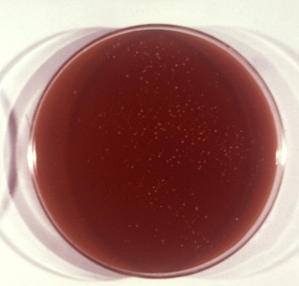

 Diagnosis and Treatment
Diagnosis and Treatment Diagnosis:
N .
Meningitidis can be detected by doing a
spinal tap to extract some Cerebrospinal Fluid from an
individual’s spine. If
this CSF that is obtained appears to be cloudy it is
most likely infected with bacterial meningitis and is
cloudy because it has been placed under increased
pressure. The
white blood cell count and protein concentration of the
CSF will also be elevated if N. Meningitidis is
present. Additionally,
Glucose levels will be reduced in the fluid.
Some of the CSF may then be tested in the
laboratory by trying to grow more of the bacteria on a
special agar plate. This
type of agar plate is called a chocolate agar because of
its color. It is
composed of approximately 5-10% mammalian blood.
The agar plate is then put in an incubator to
recreate the temperature that the bacteria will live in
within the human body. The
plate is also in a chamber with slightly elevated Carbon
Dioxide levels. Once
grown, some of the bacteria will be gram stained and if
the bacteria turn out to be gram negative along, along
with many of these other indicators; the person is
diagnosed as having a bacterial meningitis infection due
to N. Meningitidis. This picture is an
example of what a chocolate agar plate looks like.
.
Meningitidis can be detected by doing a
spinal tap to extract some Cerebrospinal Fluid from an
individual’s spine. If
this CSF that is obtained appears to be cloudy it is
most likely infected with bacterial meningitis and is
cloudy because it has been placed under increased
pressure. The
white blood cell count and protein concentration of the
CSF will also be elevated if N. Meningitidis is
present. Additionally,
Glucose levels will be reduced in the fluid.
Some of the CSF may then be tested in the
laboratory by trying to grow more of the bacteria on a
special agar plate. This
type of agar plate is called a chocolate agar because of
its color. It is
composed of approximately 5-10% mammalian blood.
The agar plate is then put in an incubator to
recreate the temperature that the bacteria will live in
within the human body. The
plate is also in a chamber with slightly elevated Carbon
Dioxide levels. Once
grown, some of the bacteria will be gram stained and if
the bacteria turn out to be gram negative along, along
with many of these other indicators; the person is
diagnosed as having a bacterial meningitis infection due
to N. Meningitidis. This picture is an
example of what a chocolate agar plate looks like.
So you've got it...now what?
Bacterial
Meningitis due to N. Meningitidis is a very serious
disease that requires immediate treatment.
In children
there are a combination of drugs that can work together
to fight the infection in some cases. Cefotaxime and
Chloramphenicol are two choices available to infants and
small children that develop the disease.
There is
research being done on drugs that regulate inflammatory
responses because antibiotic therapy has had little
effect on the fatality rate due to this organism.
Until a clear
solution is found there are some options.
There are currently four polysaccharide vaccines
that are now available for certain strains of
Check out where N. Meningitidis lives!





